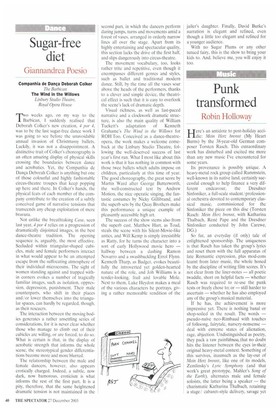Sugar-free diet
Giannandrea Poesio
Companhia de Danca Deborah Colker The Barbican The Wind in the Willows Linbuty Studio Theatre, Royal Opera House
llo weeks ago, on my way to the rbican, I suddenly realised that Deborah Colker's new creation, 4 par 4, was to be the last sugar-free dance work I was going to see before the unavoidable annual invasion of Christmassy ballets. Luckily, it was not a disappointment. A distinctive trait of Colker's choreography is an often amazing display of physical skills crossing the boundaries between dance and acrobatics. Yet, the Companhia de Danca Deborah Colker is anything but one of those colourful and highly fashionable circus-theatre troupes that keep popping up here and there. In Colker's hands, the physical feats of each member of the company contribute to the creation of a subtly conceived game of narrative tensions that transcends any cheap exploitation of mere bravura.
Not unlike the breathtaking Casa, seen last year, 4 por 4 relies on a progression of dramatically disjointed images, in the best dance-theatre tradition. The opening sequence is, arguably, the most effective. Secluded within triangular-shaped cubicles, male and female performers interact in what would appear to be an attempted escape from the suffocating atmosphere of their individual microcosms. The sight of women standing against and trapped within corners evokes a number of tragically familiar images, such as isolation, oppression, depression, punishment. Their male counterparts, who shift in their places and/or lower themselves into the triangular spaces, can hardly be regarded, though, as their rescuers.
The interaction between the moving bodies generates a rather unsettling series of considerations, for it is never clear whether those who manage to climb out of their cubicles are willing, or are forced, to do so. What is certain is that, in the display of acrobatic strength that informs the whole scene, the stereotypical gender differentiations become more and more blurred.
The relationship between the male and female dancers, however, also appears erotically charged. Indeed, a subtle, now dark, now humorous, eroticism is what informs the rest of the first part. It is a pity, therefore, that the same heightened dramatic tension is not maintained in the second part, in which the dancers perform daring jumps, turns and movements amid a forest of vases, arranged in orderly narrow lines all over the stage. Apart from its highly entertaining and spectacular quality, this section lacks the drive of the first half, and slips dangerously into circus-theatre.
The movement vocabulary, too, looks rather trite and repetitive, even though it encompasses different genres and styles, such as ballet and traditional modern dance. Still, by the time all the vases soar above the heads of the performers, thanks to a clever and simple device, the theatrical effect is such that it is easy to overlook the scene's lack of dramatic depth.
Visual richness, as well as fast-paced narrative and a clockwork dramatic structure, is also the main quality of William Tuckett's adaptation of Kenneth Grahame's The Wind in the Willows for ROH Too. Conceived as a dance-theatreopera, the work makes a welcome comeback at the Linbury Studio Theatre, following the well-deserved success of last year's first run. What I most like about this work is that it has nothing in common with those twee ballets which adults impose on children, particularly at this time of year. The good choreography, the great score by Martin Ward after George Butterworth, the well-constructed text by Andrew Motion, the nice operatic singing, the fantastic costumes by Nicky Gillibrand, and the superb sets by the Quay Brothers make this performance a unique example of pleasantly accessible high art.
The success of the show stems also from the superb cast. Matthew Hart, as Toad, steals the scene with his Silent-Movie-like antics. and Will Kemp is simply irresistible as Ratty, for he turns the character into a sort of early Hollywood movie hero — halfway between a dashing Ramon Novarro and a swashbuckling Errol Flynn. Kenneth Tharp, as Badger, evokes beautifully the introverted yet golden-hearted nature of the role, and Joh Williams is a tender-looking, frail and lovable Mole. Next to them, Luke Heydon makes a meal of the various characters he portrays, giving a rather memorable rendition of the jailer's daughter. Finally, David Burke's narration is elegant and refined, even though a little too elegant and refined for a younger audience.
With no Sugar Plums or any other tutued fairy, this is the show to bring your kids to. And, believe me, you will enjoy it too.


























































 Previous page
Previous page